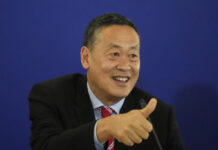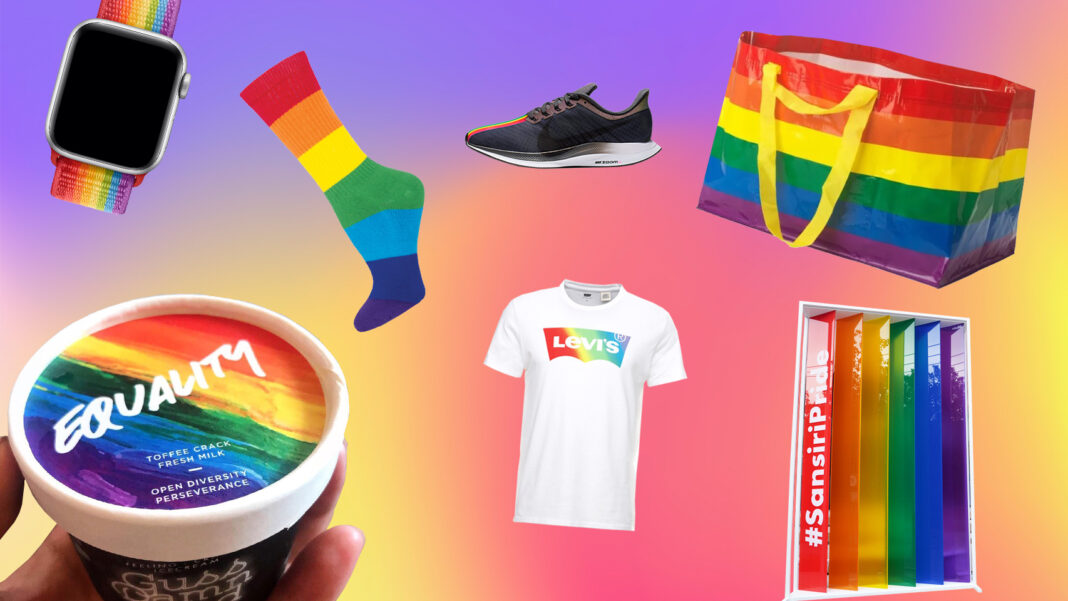Photo: Courtesy
During Pride Month, multinational brands worldwide temporarily adorned their logos and products with rainbows in a showing of apparent solidarity with the LGBT community. Thai brands joined the marketing trend too: real-estate giant Sansiri dyed its logo rainbow, while independent ice-cream chain Guss Damn Good rolled out new flavors to mark the month. Even the Tourism Authority of Thailand (TAT) ran an ad featuring LGBT couples.
But the marketability of the LGBT cause has given rise to “pink capitalism” – a negative term usually leveled at corporations who temporarily market a message of support for LGBT rights, while continuing to engage in exclusionary or discriminatory practices. Members of the Thai LGBT community and activists welcomed the public support for Pride Month, but doubts linger over the sincerity of brands’ attempts to capitalize on the lucrative purchasing power of queer communities.
“I’m grateful to see the bravery [of brands] in coming out to support our community,” the director of the Transgender Alliance for Human Rights, Jetsada Taesombat, said. “However, we can’t simply conclude that a company is gay-friendly from their products. We have to look deeper into corporate structures to see who they really are.”
Despite Sansiri’s rainbow campaign, for example, exclusion remained clearly visible in a recent job ad for a hotel service role that specified “men only.” Jetsada says such a stipulation is commonplace but illegal under the Gender Equality Act.
Sansiri did not respond to a request for comment.
The pink market
Thailand’s LGBT population is a valuable market. A 2016 report, released jointly by the marketing firms INTO and Brand Innovators, estimated that the global LGBT population engages in aggregate spending worth more than USD$5 trillion each year.
“It’s no longer a niche market,” said Boonying Kongarchapatara, assistant dean of the College of Management at Mahidol University. “The LGBT population is huge, but it’s not easy to win over.”
There are about 450 million individuals identifying as LGBT worldwide, with more than half living in Asia, according to estimations by US-based venture capital firm LGBT Capital. Thailand has the fourth-largest queer population in Asia, comprising four million.
But the community is not only lucrative because of sheer numbers. From a survey of 500 self-identified LGBT Thais, Boonying found that members of the queer community tend to have higher purchasing power and more savings than straight counterparts.
“They have higher purchasing power because they often have no children, which is referred to as DINK, or dual income, no kids,” Boonying said. “They tend to save more money because they feel insecure about their futures. Some fear that they will be single for the rest of their lives.”
In other words, Boonying found that LGBT consumers are more inclined to spend on themselves – for example on appearances through clothing, cosmetics, and health purchases. Boonying argues further that members of the LGBT community generally spend more on appearances because looks matter for confidence and acceptance: two experiences that marginalized members of society yearn for.
Data collected by Boonying on the average amount that different demographics spend on clothing per transaction found that gay individuals spend the most at 2,835 baht, followed by transgender individuals at 2,225 baht. Bisexual individuals spent 2,100 baht per transaction while lesbian individuals spent 1,800 baht per transaction.
Another big chunk of “pink money” is spent on travel. According to a 2012 report from the UN World Tourism Organization, gay individuals take an average of 3.9 trips each year, while lesbian individuals average 3.3 trips.
In 2018, TAT ran a campaign targeting LGBT tourists called “Open to New Shades,” which aimed to showcase the country as a “safe, tolerant and respectful” destination.
“[Members of the LGBT community] spend three times more than the average tourist,” TAT deputy governor Srisuda Wanapinyosak explained. “We also believe that they can fill out the gap during the low season, as they don’t have to wait for school breaks.”
Pink-washing
Other members of Bangkok’s queer community are concerned that companies are merely jumping on the “pink-washing” bandwagon, but haven’t put due diligence into researching the kinds of messaging and campaigning that would really benefit the LGBT community.
Tumpapon “Max” Torsupsin, a gay employee at software development firm Aware Corporation, suggests that brands actively consult queer communities themselves – especially internal LGBT employees.
“I think businesses should consult LGBT employees before making a policy or campaign about queer people,” Max said. “I’m not sure that campaigns only informed by the ideas of straight people would understand what we really need. Even worse, they might carry a stereotypical image of who we are.”
Max also echoed Jetsada’s criticism of companies that hypocritically preach support for queer rights while continuing discriminatory practices.
“Rainbow logos are useless if your company is not open to LGBT people,” Max said. “I was about to join a multinational corporation before I came to Aware, but I declined their offer because I was asked whether I would dress as a girl to work. I felt humiliated, so I chose to work with this smaller firm instead.”
In 2018, a report from the World Bank revealed that more than half of surveyed LGBT Thais had experienced discrimination at work. Transgender individuals endured the most at 60 percent, followed by lesbian individuals (30 percent), and gay individuals (20 percent).
“My gender identity is respected here. No one questions my gender, which makes me confident to put forward my ideas to colleagues,” Max continued.
Guss Damn Good also stressed the serious preparation and consultation that went into preparing its Pride Month flavours.
“We didn’t create the flavors out of nowhere. We held a workshop gathering our LGBT customers to brainstorm what pride meant to them,” said co-owner Phatjira Simanonthaparinya.
Two flavors emerged from the lengthy discussion. “Equality” was a milk ice cream drizzled with rainbow sprinkles, while “Love Is Love” added unorthodox pink to usually white or green lime ice cream.
Customers lined up for the Insta-worthy rainbow ice cream tubs, but Phatjira admitted that the campaign was only symbolic and no monetary contribution was given to the queer community.

Getting future campaigns right
Although research on Thailand’s queer market still lacks vital statistics, such as the average amount that individuals spend across industries, researchers such as Boonying hope their work can help marketing professionals better target the desires of queer communities.
“I believe it’s time for marketers to consider the LGBT community as a new demographic apart from men and women,” Boonying said. “For example, transgender women may share similar preferences to women, but they might want something that is customized specifically if they have a physically masculine body.”
The right balance involves running noteworthy campaigns that matter to LGBT communities, while simultaneously making sure day-to-day campaigns still resonate with people regardless of gender or sexuality.
“You can create new demands but you have to make sure that they don’t alienate [LGBT communities] from the rest of the market,” Boonying said. “LGBT people just want to be treated as ordinary consumers.”














































